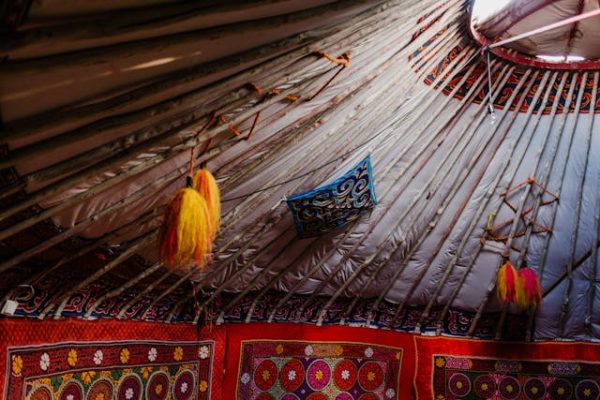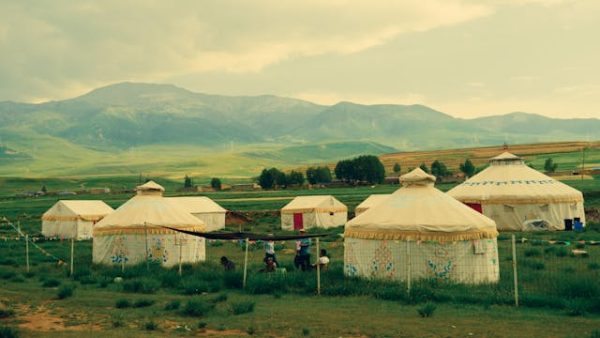
Nomadic peoples expertly crafted tents suited to their migratory lifestyles. These temporary shelters provided portability, easy setup, and protection from the elements. Let’s explore the incredible nomad tents designs of nomadic cultures across the world.

Mongolian Ger
Mongolians lived in gers, circular tent structures used by nomads in Central Asia.
- Design
Gers consist of a collapsible wooden circular frame covered in felt. A cone-shaped roof supported by center poles lets rain and snow slide off. A thick felt door flap provides entry. The ger’s round design makes it wind-resistant.
- Portability
Gers can be quickly dismantled, transported by horses or camels, and rebuilt. Mongolians frequently relocated campsites. The lightweight ger home traveled with them.
- Multi-Purpose
Though small, gers functioned as kitchens, living rooms, and bedrooms. Families socialized, cooked meals, slept, and tended to animals inside. A fire pit heated the ger in winter.

Native American Tipi
Tipis were portable hide tents used by Plains Indian tribes who hunted buffalo across the prairies.
- Design
Consider Qtents for the best tent designs. Sturdy poles formed a tall cone shape covered in buffalo hides or birch bark. Smoke flaps at the top provided ventilation for fire pits. The base was secured with pegs and overlaying hides.
- Portability
Tipis could be quickly dismantled, loaded onto dogsleds in winter or horses for transport, then rebuilt at new campsites. Tepee poles were collapsible for travel.
- Customization
Tribes painted exterior hide covers with symbolic designs representing the owner’s achievements in battle or hunting. The tipi decor identified the inhabitant.
Bedouin Tent
In the deserts of Northern Africa and the Middle East, nomadic Bedouin tribes resided in tents woven from goat hair.
- Design
The tents feature thick rectangular bases with center support poles holding up roof flaps. Wall dividers create separate spaces. Fleece blankets provide flooring.
- Portability
Tents disassemble into compact bundles transported by camels. Tribes frequently migrated with their livestock to new grazing grounds.
- Multi-Purpose
Bedouin tents divided into areas for sleeping, cooking, and socializing. Wealthier families had elaborate tent designs with concrete floors, plush rugs, and ornate textiles.
Berber Tent
The nomadic Berber people of Morocco resided in sturdy tents called khaimas.
- Design
Berber tents consist of wooden poles covered in woven goat hair fabric or wool. The small entrance has a flap for privacy and insulation. Interior poles support the peak roof.
- Portability
Tents dismantle for transport by camel or donkey caravans across the Sahara desert. Berbers frequently relocated their villages seeking grazing lands.
- Multi-Purpose
Each tent functioned as a family residence. Mothers weaved carpet partitions to create separate areas for sleeping, cooking and social gatherings within the khaima.

Yurt
Central Asian nomads like Mongolians utilized yurts, round tent-like dwellings with collapsible wooden frames.
- Design
Latticed walls made of wood strips or bamboo fold down into a cartwheel design. Felt cloth wraps the walls and conical roof for insulation and weather resistance. A stoved hearth sits in the center.
- Portability
Yurts disassemble onto animal transport for migration across the steppes. The components stack together in a compact cylindrical bundle.
- Multi-Purpose
Yurts contain sleeping platforms around the edges and communal space for cooking, eating and socializing. They provide a simple yet comfortable shelter.
Lakota Tepee
Plains tribes like the Lakota erected hide tepees for portability when following buffalo herds.
- Design
Tepees used tall wooden poles lashed together at the top and covered with buffalo hides. A flap opening and smoke flaps allowed airflow.
- Portability
Lakota packed tepees onto travois sleds dragged by dogs in winter. In summer, horses transported the collapsed poles and hides.
- Customization
Tribes painted tribal symbols on the exterior to identify the inhabitant’s family heritage. Tepees reflected the owner’s identity.
Conclusion
Across continents, nomads invented tents ideal for transport and survival through harsh environments. Their ingenious designs allowed tribes to migrate vast distances while maintaining shelter, community, and culture. The collapsible homes exemplify necessity driving innovation.

